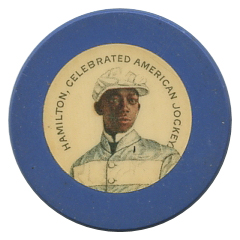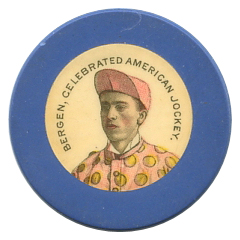| Return to New York | |||||||||||
|
|
|||||||||||
| Jockeys | |||||||||||
| W.S. Kimball & Co. | |||||||||||
| Rochester, NY | |||||||||||
| Front: Tod Sloan; Reverse: Fred Taral | |||||||||||
     |
|||||||||||
| Front: Tony Hamilton; Reverse: Marty Bergen | |||||||||||
  |
|
||||||||||
|
Before there were crest & seals there were pinbacks/buttons. The size of the pinback below is the exact size of the inlay of the crest & seal. The manufacturer of the pinback/button/inlay was Whitehead & Hoag of Newark, NJ. W&H patented the pinback making process in 1896 (see patent below). The reason that the c&s seal inlay was made of paper and celluloid was because that was what W&H used in making their pinbacks. Little Jockey Cigarettes were made by W. S. Kimball & Co. of Rochester, NY. The same jockey pinback was also made for the American Pepsin Gum Co. However it is felt that poker chips, being for adults, would be an advertising item for a cigarette/cigar company (ala Chauncey Olcott and Anona Cigars). These chips, made by USPC using W&H inlays, are presumed made between 1896 and 1910. After 1910, USPC made their own inlays. A problem with W&H inlays lie in the fact that the composition of the inlay was paper and celluloid. As the inlay dried out there would be tension between the paper and celluloid resulting in a warping or lifting of the inlay. If the edged lifted, any moisture that found its way under the inlay would stain the paper. This was never a problem with the pinback since the inlay was wrapped around a metal saucer. The edge of the inlay was then securely and permanently held in place by a metal ring (see patent drawings below). |
|||||||||||
 |
|||||||||||
 |
|||||||||||